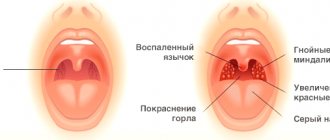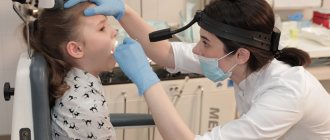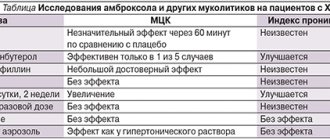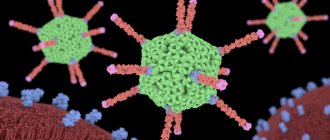How does inflammation occur?
About 70% of acute inflammatory diseases of the pharynx are caused by viruses2. In acute viral infections, the most common symptoms include: sore throat, weakness, cough, and fever. In children it is high (38 degrees and above), and in adults it is within 37-38 degrees. Of course, the intensity of the temperature depends on the specific pathogen: for example, during the flu it rises sharply above 38 degrees, and rhinoviruses, for example, practically do not cause high fever. In addition, other symptoms appear: headache, sweating, chills.
Today, about 250 viruses are known that can cause a “cold.” The most common of them are rhinoviruses, adenoviruses, Epstein-Barr virus, Coxsackie virus, coronavirus1.
In addition to viruses, acute inflammation of the pharynx is caused by bacterial and fungal infections. The most common cause of sore throat is streptococcus pyogenes. A bacterial infection feels almost no different from a viral one: the same high temperature, the same manifestations of intoxication. But it is possible to become infected with several bacteria at once - for example, streptococcus and Staphylococcus aureus. These bacteria are dangerous because... can provoke the development of pneumonia, therefore, if the temperature rises sharply and you feel weak and dizzy, you should urgently consult a doctor to determine the disease. There are also rapid tests that quickly help determine the cause of the disease (for example, the causative agent of a sore throat) even at home.
Don't discount fungal flora either. The most common pathogen in this case is the fungus Candida albicans, better known among the people as the “causative agent of thrush” - they cause almost every second fungal inflammatory process of the nasopharynx3.
But the most common option is mixed flora. The virus that originally caused the disease “prepares the ground” for a bacterial infection, which easily develops on the inflamed mucous membrane, which has lost its natural protective properties. Taking certain antibiotics can also become a catalyst, in which case a fungal infection will occur.
Prolonged sore throat is caused by bacteria and fungi, which are a source of chronic infection, for example, with sinusitis, tonsillitis or caries.
In children, constant soreness can be caused by inflammation of the palatine tonsil - adenoiditis - with the main irritating factor being the inflammatory secretions flowing down the back wall of the pharynx.
general characteristics
A sore throat is felt as discomfort in the form of tingling, tickling, burning, rawness in the area of the palatine arches, tonsils, back wall of the pharynx or slightly lower in the larynx.
Often the symptom is combined with a slight cough, which occurs involuntarily or is taken to get rid of unpleasant sensations. As symptoms progress, a painful dry cough may develop. In emotional patients with a low pain threshold, the sore throat quickly gives way to a sore throat of varying intensity. The symptom is often preceded by contact with infectious patients, stay in an area of unfavorable epidemiological situation. Less commonly, sore throat develops after contact with the mucous membrane of the throat by irritating substances or injury during eating. Discomfort in the laryngopharynx can become one of the first symptoms of diseases in which the lower parts of the respiratory system and adjacent organs are involved in the pathological process, a harbinger of infections, including difficult-to-control infections - swine and Hong Kong flu, West Nile fever, etc.
Diagnosis of pharyngitis
Typically, the ENT examines the patient's throat, as well as his nose and ears, carefully palpates the lymph nodes, and listens to breathing using a stethoscope.
The streptococcal test is a simple and accurate way to diagnose bacterial pharyngitis. The doctor takes a scraping from the child's throat, and within 24-48 hours the result is ready. Streptococcal pharyngitis will have to be treated with antibiotics.
We have our own laboratory in the clinic, so you can always take all the necessary tests with us!
Causes of sore throat
The occurrence of the symptom is usually associated with various inflammatory and non-inflammatory processes both in the respiratory tract and in the organs that are located next to the pharynx and larynx. Less commonly, irritation of the pharyngeal mucosa is of physiological origin and is caused by eating spicy or too hot food, inhaling frosty air while walking or running quickly. Itching, caused by dry mucous membranes, is observed when the overall humidity in the room decreases.
Inflammation of the oropharynx
Pathological processes involving the mucous membrane of the oropharynx are the most common cause of soreness. The development of the symptom is due to irritation of nerve endings due to swelling and infiltration of the mucous membrane, release of inflammatory mediators, vasodilation and desquamation of the affected epithelium. Perspiration occurs against the background of diseases such as:
- Respiratory viral infections
. Most ARVI pathogens have a high affinity for epithelial cells of the oropharynx and larynx. After the introduction of influenza viruses, parainfluenza, rhinoviruses, and other viral particles, a local inflammatory reaction is formed, accompanied by soreness and then pain in the throat. In some diseases, discomfort in the throat precedes damage to other systems: the digestive tract (rotavirus infection), lungs (coronaviruses), lymphatic tissue (infectious mononucleosis), parenchymal organs and skin (rubella). - Bacterial inflammation
. A sore throat caused by persistent bacteria is often observed with streptococcal infections. Significant discomfort is observed with sore throat, acute pharyngitis and chronic tonsillitis. Severe itching caused by mucus draining from the nose and spasmodic coughing is characteristic of whooping cough. Severe nasopharyngitis with severe intoxication is observed with meningococcal infection. Moderate tickling in combination with other catarrhal symptoms manifests itself as a flu-like form of psittacosis. - Catarrhal reaction in other infections
. Discomfortable tickling sensations occur at the initial stage of some acute and chronic infectious diseases that cause systemic damage to the body. Flu-like sore throat is possible in patients with developing viral hepatitis A, pseudotuberculosis and secondary syphilis. A feature of the symptom in such pathological conditions is its frequent combination with general intoxication, arthralgia, myalgia, skin rashes and other signs of multiple organ disorders.
Severe erosive and ulcerative destruction of the epithelium with intense soreness and soreness in the throat is observed in infectious diseases of the oropharynx and nasopharynx against the background of decreased immunity (pharyngomycosis, lesions of the ENT organs in HIV-infected people). The symptom is felt more pronounced against the background of ARVI during pregnancy, which is associated with physiological suppression of the body’s defenses and increased emotionality of pregnant women.
Non-inflammatory pathology of the oropharynx
Irritation with the appearance of characteristic scratchy sensations is observed when the mucous membrane is exposed to non-infectious factors - mechanical trauma, pressure from space-occupying formations. Sometimes the symptom is provoked by food intake (damage from solid foods, fish bones), stress, conflict, or anxiety. In non-inflammatory diseases, hyperthermia and other signs of general intoxication are often absent, but copious pathological discharge (mucous, bloody discharge) is possible.
Perspiration is observed when tissue is damaged by foreign bodies, the presence of a tonsil cyst, or benign tumors of the pharynx. In a Le Fort 1 fracture of the upper jaw, a tickling sensation is associated with a downward displacement of the uvula of the soft palate and, as a rule, is combined with nausea and obstruction of the upper respiratory tract. In rare cases, the symptom has a functional origin and develops against the background of a hyperesthetic variant of pharyngeal neurosis, accompanied by a feeling of dry mucous membranes and a lump in the throat.
Diseases of the larynx
The occurrence of uncomfortable tickling sensations is associated with the anatomical proximity of the pharynx and the upper respiratory tract, the possibility of ascending or descending spread of inflammatory and destructive processes, and vascular reactions. In this case, the tickling is combined with characteristic voice disorders - dysphonia or aphonia. The causes of the symptom are usually:
- Inflammatory diseases
. Specific manifestations of soreness for acute or chronic laryngitis include a feeling of dry mucous membranes, burning, tickling, and scratching. Discomfort is first localized in the upper part of the neck, then it can spread to the back wall of the pharynx. In chronic hyperplastic laryngitis, in addition to soreness and hoarseness, a foreign body sensation is often noted. For laryngotracheitis, a combination of a tickling sensation and a cough is typical. General intoxication is often mild or moderate. - Neurotic disorders
. A persistent subjective sensation of tickling sensation in the laryngopharyngeal region is a characteristic sign of voice formation disorders with functional paresis of the larynx. The feeling of discomfort is aggravated by pain and a transient change in phonation. There are no visible signs of inflammatory or other pathological processes, the voice remains quite sonorous during laughter, coughing and crying, other neurotic stigmas are detected: complaints of headache, emotional lability, fatigue, insomnia.
The occurrence of soreness at the level of the larynx is also possible with the development of benign tumors, cancer of the hypopharynx and larynx. Such uncomfortable sensations are particularly persistent and are combined with progressive voice impairment and breathing difficulties. When the tumor is localized in the lower part of the pharynx, abundant salivation is observed.
Thyroid diseases
The development of tickling sensations when thyroid tissue is damaged is facilitated by the anatomical location of the organ in the upper part of the trachea, its innervation by the recurrent laryngeal nerve, the fibers of which provide sensitivity and motility of the larynx. A sore throat in the middle and lower part of the throat is accompanied by thyroid nodules and cysts, papillary cancer, and other neoplasms growing in the direction of the respiratory tract. In the later stages of the volumetric process, breathing difficulties and visible deformation of the neck are also detected. Possible signs of hyperthyroidism: emotional lability, irritability, exophthalmos, tachycardia.
Allergy
Various types of discomfort in the nasopharynx and oropharynx are typical for acute atopic reactions and chronic allergic diseases. In the first case, tickling occurs suddenly, is combined with nasal congestion, lacrimation, sneezing and skin itching, most often manifested by allergies to dust, pets, or pollen. As a concomitant symptom, tickling sensations in the larynx and pharynx are noted during paroxysmal cough with difficulty breathing and expiratory shortness of breath in allergic bronchitis. The cause of the development of soreness in allergies is usually irritation of the mucous membrane due to the release of histamine and other inflammatory mediators by mast cells under conditions of sensitization to a particular allergen.
Bronchopulmonary pathology
The causes of discomfort in the pharynx and larynx during diseases of the bronchi and lungs are usually irritation of the mucous membrane when it comes into contact with expectorated sputum, other pathological discharge and a reaction to a strong cough. With tracheobronchitis and acute bronchitis, tickling is often combined with rhinorrhea or dry nasopharynx, hoarseness, and pain when swallowing. Symptoms of acute respiratory infections with a tickling sensation sometimes appear in the initial stages of certain types of pneumonia - atypical mycoplasma and caseous pneumonia.
With aspergillus tracheobronchitis and interstitial pneumonia, the main clinical symptoms are preceded by persistent discomfort in the pharynx, larynx with hyperthermia and a persistent feeling of bitterness in the mouth. Soreness and changes in voice accompanied by a persistent cough, pain when inhaling, and expiratory shortness of breath are observed during secondary infection in patients with osteochondroplastic tracheobronchopathy. Most pathological processes accompanied by hemoptysis also occur with a tickling sensation.
Esophageal damage
The development of symptoms in patients suffering from esophageal pathology is often caused by the reflux of gastric contents due to violations of the closure function of the cardia. When aggressive secretions and digested food enter the esophageal mucosa, irritation spreads to the upper sections. In addition, when belching occurs, the acidic contents of the stomach directly affect the epithelium of the pharynx, causing a local response.
Perspiration is observed with gastroesophageal reflux disease, especially against the background of GERD during pregnancy, when there is a higher reflux of liquid gastric chyme. Such tickling sensations with a burning sensation in the hypopharynx, dysphagia, coughing up large amounts of mucus and dysphonia are caused by laryngopharyngeal reflux. Scratching of the throat, dry cough, excessive salivation, and a “lump in the throat” are characteristic of diverticulosis of the esophagus with the formation of pharyngoesophageal pouch-like protrusions (Zenker’s diverticulum).
Occupational pathology
Irritation of the laryngopharyngeal mucosa associated with the performance of work duties is observed with inhalation of toxic substances and high vocal load. Occupational diseases, the clinical picture of which may include a sore throat symptom, can occur both acutely and chronically. Patients often experience voice changes and signs of damage to the bronchi and lungs. The causes of tickling sensations in the larynx and oropharynx can be:
- Acute poisoning
. Acute berylliosis, foundry fever and toxic pulmonary edema begin with a feeling of dry mucous membranes, soreness in the larynx and pharynx, an unusual taste in the mouth, and sometimes watery eyes. Subsequently, the clinical picture quickly worsens with hyperthermia, myalgia, paroxysmal cough, chest pain, and worsening general condition. - Chronic intoxication
. Changes in the mucous membrane of the laryngopharynx, manifested by soreness, are possible with pneumoconiosis and respiratory allergies. In patients suffering from occupational bronchial asthma and byssinosis, the symptom is often combined with difficulty inhaling and exhaling, coughing, shortness of breath, and then respiratory failure. - Damage to the vocal folds
. In specialists whose activities involve overload of the vocal apparatus, soreness is caused by local hyperplasia of the connective tissue. When nodules of the vocal cords appear, in addition to laryngopharyngeal discomfort and burning, the voice becomes hoarse, fatigue is noted, and an unproductive cough occurs.
Which specialist should I contact?
Diagnosis of pathological processes is carried out by specialists of various profiles.
- If there is a problem with the gastrointestinal tract, you will need to consult a gastroenterologist.
- If you have allergic pathologies, you cannot do without consulting an allergist-immunologist.
- Innervation disorders are treated by neurologists.
- Tumors are the field of activity of oncology specialists.
- Finally, infectious diseases are treated by general practitioners.
First of all, it is recommended to see a doctor of the widest possible profile. That is, the therapist. He is a kind of beacon. A general practitioner carries out initial routine measures, determines the nature of the pathological process and refers the patient to specialists.
- Severe sore throat, sore throat and dry cough - possible causes and treatment at home
At the initial appointment, any doctor asks questions about the state of health, complaints, their duration and nature.
An anamnesis is collected (the doctor finds out what the person was or is sick with). It is mandatory to establish the presence of allergies and previous infectious diseases.
Survey
The diagnostic search is aimed at establishing the underlying disease, manifested by a sore throat. The initial examination is usually prescribed by an otorhinolaryngologist (ENT doctor). A specialized examination includes pharyngoscopy, laryngoscopy and rhinoscopy, during which the mucous membrane of the pharynx, larynx, vocal cords and nasal passages is examined to identify possible pathologies. If necessary, additional research methods are prescribed to assess the condition of the ENT and other organs, diseases of which may cause soreness:
- Endoscopic ENT procedures
. More detailed information about the extent of possible damage to the mucous membranes can be obtained using endoscopy of the larynx and nasal cavity. If questionable pathological foci are detected, an endoscopic biopsy of the ENT organs is performed, followed by histology of the biopsy sample. - Diagnosis of infections
. To confirm the infectious genesis of the disease, a throat smear is cultured for microflora. Streptatest is used as a rapid method for detecting group A beta-hemolytic streptococcus. PCR, RIF, and ELISA have high diagnostic value. - X-ray studies
. Quick methods for determining bronchopulmonary pathology are fluorography and chest radiography. In complex diagnostic cases, it is recommended to conduct tomographic studies (thoracic CT, MRI, MSCT), lung scintigraphy, and bronchoscopy. - Ultrasound examination of the thyroid gland
. The method is used as a screening, since the occurrence of soreness may be associated with space-occupying formations of thyroid tissue. During an ultrasound of the thyroid gland, the structure of the organ, its size, diffuse or focal changes are assessed. - Endoscopy of the esophagus and stomach
. To exclude gastroenterological prerequisites for the appearance of sore throat and larynx, gastroscopy and esophagoscopy are performed. Visual examination with possible biopsy of suspicious tissue is the fastest and most accurate method for identifying gastroesophageal pathology.
Gargling with antiseptics and herbal decoctions - symptomatic therapy for sore throat
What is pharyngitis?
This is an inflammation of the mucous membrane of the pharynx and its lymphoid tissue. With pharyngitis, the throat is sore, sore and irritated. The pain intensifies when swallowing. Pharyngitis usually develops with influenza and ARVI. Viral pharyngitis usually goes away on its own. Some other less common forms of pharyngitis may require treatment.
IMPORTANT! Information from the article cannot be used for self-diagnosis and self-medication! Only a doctor can prescribe the necessary examinations, establish a diagnosis and draw up a treatment plan during a consultation!
Symptomatic therapy
A short-term sore throat caused by eating errors, inhaling cold or dry air, or other non-pathological causes usually goes away on its own. To alleviate discomfort, steam inhalation of essential oils using a nebulizer, sprays or lozenges with antiseptic and local anesthetics can be used. Until the condition normalizes, it is recommended to limit the consumption of spicy, hot, sour and salty foods, cold and highly carbonated drinks.
If there is a combination of sore throat and signs of a possible infection (sore throat, watery eyes, runny nose, high temperature), you should contact an otolaryngologist or local physician (pediatrician), and if the condition quickly worsens, call an ambulance. Before examination by a specialist, inhalations, gargling with anti-inflammatory herbal decoctions, and the use of local painkillers (lozenges, sprays) are allowed. It is important to take care of humidifying the air in the room. Self-medication with antibiotics is strictly prohibited.
Risks and measures to prevent pharyngitis
Pharyngitis most often affects children and adolescents; adults also get sick, but somewhat less frequently. Also, the risks of pharyngitis increase with dry air, throat irritation from tobacco smoke or chemical reagents, allergies, weakened immunity, chronic or frequent infections of the nasopharynx.
You can reduce the likelihood of illness in the same way as in the case of other nasopharyngeal infections: wash your hands, do not drink from the same cup with others, cover your mouth when coughing and sneezing (do not “share” your viruses), wipe the screen and keyboard of phones and other devices etc.









